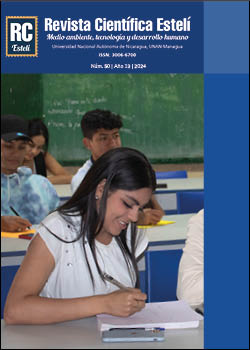Understanding the first law of thermodynamics: teaching strategies and applications
DOI:
https://doi.org/10.5377/esteli.v13i50.18475Keywords:
First Law of Thermodynamics, Felder inventory, learning, proposalAbstract
The teaching-learning process involves the use of various activities and strategies aimed at transmitting knowledge, skills and values to students. This study aims to design a didactic proposal that provides effective tools for teaching and learning the first law of thermodynamics. These tools are closely related to the scientific aspects of this law and the predominant learning style of students, according to psychological aspects. In accordance with the recommendations of the Ministry of Education (MINED), the use of active methodological strategies is promoted, supported by technological tools that dynamize, motivate and facilitate learning. These strategies should also strengthen written expression, the research process, and critical and reflective analysis, necessary for problem solving in the students’ environment. The study focused on developing didactic strategies for teaching the first law of thermodynamics, adapted to the students’ learning preferences, identified through Felder’s inventory. The aim is to connect theoretical foundations with everyday life through project-based learning. A qualitative approach was adopted. Initially, the predominant learning style among students was diagnosed using Felder’s inventory. Subsequently, a didactic proposal was designed based on active learning and the use of educational technologies. This proposal included practical activities, projects and critical reflection exercises. Data were collected through observations, surveys and academic performance evaluations. These data were analyzed to evaluate the relevance and effectiveness of the strategies implemented.
Downloads
References
Batista, G. G. (2002). Compendio de Pedagogía. https://pdfcoffee.com/compendio-de-pedagogia-pdf-free.html
Bauer y Westfall. (2011). Fisica para ingeniería y ciencias. México: Mc Graw Hill.
Casal Jordi, E. M. (3 de Marzo de 2003). Tipos de Muestreo . http://mat.uson.mx/~ftapia/Lecturas%20Adicionales%20(C%C3%B3mo%20dise%C3%B1ar%20una%20encuesta)/TiposMuestreo1.pdf
DGB. (22 de agosto de 2004). Manual de Estilos de Aprendizaje - Dirección General del Bachillerato: http://biblioteca.udgvirtual.udg.mx/jspui/bitstream/123456789/1002/1/Manual%20Estilos%20de%20Aprendizaje%202004.pdf
Ferreiro, R. (2003). Estrategias Didácticas de Aprendizaje Cooperativo. Mexico: Trillas.
Hewitt, P. (2016). Física Conceptual. México: Pearson.
Márquez Vázquez, F., López Garduño, L., & Pichardo Cueva, V. (2008). Una propuesta didáctica para el aprendizaje centrado en el estudiante. Apertura, 8(8), 66-74. https://doi.org/http://www.redalyc.org/articulo.oa?id=68811215005
Mata Solis, L. D. (28 de Mayo de 2019). El enfoque cualitativo de investigación. https://investigaliacr.com/investigacion/el-enfoque-cualitativo-de-investigacion/
Rosales y Hernández (12 de enero de 2016). Repositorio UNAN - Managua. https://repositorio.unan.edu.ni/3467/1/11071.pdf
Sampieri, R., Collado, C., & Baptista, M. (2014). Metodología de la Investigación. México: Mc Graw Hill Education.
Schunk. (2012). Teorías del Aprendizaje. México: Pearson Eduaction.
Serway y Jewett. (2008). Física para ciencias e ingeniería. Mexico: Cengage Learning Editorial.
Tippens. (2010). Física Conceptos y Aplicaciones. Buenos Aires: McGraw Hill .
Wilson et al. (2007). Física. México: Pearson Educacion.
Zemansky, S. (2012). Física Universitaria. Mexico: Pearson Educacion.
Downloads
Published
Issue
Section
License
Copyright (c) 2024 Revista Científica Estelí

This work is licensed under a Creative Commons Attribution-NonCommercial-ShareAlike 4.0 International License.

